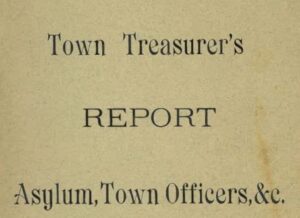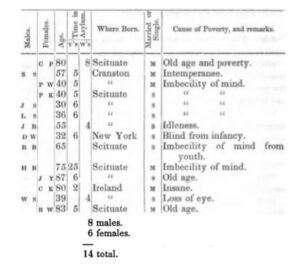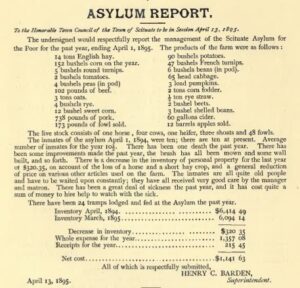 Cover for the 1895 Treasurer's Report: Scituate, Rhode Island (Providence: J. R. Day Printer, 1895).
Cover for the 1895 Treasurer's Report: Scituate, Rhode Island (Providence: J. R. Day Printer, 1895).
Seven hundred thirty-eight pounds of pork, 152 bushels of corn, 65 heads of cabbage, 3 tons of oats, and 60 gallons of cider – and, no, this isn’t a farmer’s market. These items represent just a sampling of the produce sold in 1895 by the town asylum of Scituate, Rhode Island. The whole summary of the institution’s annual revenue and expenses may be found at the North Scituate Public Library’s local history room.
I came across these documents while researching a family living in Scituate. The 1870 federal census showed a traditional family unit living alongside what appeared to be ten strangers. These people had some of cruel designations which nineteenth-century America often reserved for the unfortunate: pauper, insane, deaf, imbecile. The head of household, George W. Smith, described himself as the manager of the town asylum. My immediate interpretation was that George W. Smith and his family were running an asylum out of their home and living with the patients.
That seemed unbelievable to me. But research showed that Smith’s living circumstances were part of a common nineteenth- and twentieth-century practice. The Scituate Asylum was a poor farm, and the Smith family operated it in the year 1870.
Poor farms in America have their roots in England. The idea behind the poor farm was that the town’s homeless, mentally ill, and elderly populations could have a place to live and work when no one else remained to take care of them. They were early institutions designed to provide social services to the needy. The poor farm was illustrative of popular nineteenth-century thinking which derided poverty and mental illness as moral failures that could be corrected through hard work. In America, these institutions were run on the county or town level and could be incorporated with county penal systems. It is no surprise that a modern look at these institutions reveals abusive relationships and a failure to provide social services.
I return to the Scituate Asylum. The documents I have seen reveal a difficult life inside. Many of the expenses reported in 1851 and 1895 accounted for burials, headstones, hospital visits, and medications. The most common expenses, however, appear to be for deliveries to and from the asylum. Reading these reports gives you the sense that this poor farm was a business concerned with sending its goods to market and taking in the income.
 Table showing the state and number of residents at the Scituate Asylum in 1851. Taken from Report on the Poor and Insane in Rhode Island 1851 (Providence: Joseph Knowles, State Printer, 1851).
Table showing the state and number of residents at the Scituate Asylum in 1851. Taken from Report on the Poor and Insane in Rhode Island 1851 (Providence: Joseph Knowles, State Printer, 1851).
The 1851 report stresses that the asylum did provide social services apart from the business side. The author, Benedict Lapham, who conducted a statewide report on the state of Rhode Island’s asylums that year, stressed that the residents were kindly and humanely treated and offers some examples to convince his readers that the asylum was serving its purpose. He discusses how the children of the poor farm were allowed to attend the nearby school and that residents were allowed to worship however they liked. Lapham undercuts this point, in my view, by immediately assessing the profitability of the farm. Since the farm opened in 1844 the cost of aiding the town poor was $1,700.00. After the farm was purchased that price dropped to $400.00.
A note I found from an unknown individual described to me as a town historian illustrates the origin story of the farm very well:
Until the year 1818 the poor of the town had been kept all together, by one person, and were assigned annually at town meetings to the lowest bidder. The question of purchasing a farm for the poor first came up in 1836. Several committee reports were rejected, but on September 25, 1844, a committee agreed to buy 100 acres from Josiah Whitaker.
A superintendent was appointed to keep the poor and to take charge of the farm. The asylum continued to exist on the George Washington Highway in Clayville until the buildings were finally torn down in 1956.
The Social Security Act of 1935 started the slow decline of the poor farm. With the federal government relieving county and town officials of this burden, the practice of poor farms died off. My own research into the Scituate Asylum has shown that managers and town officials managed multiple responsibilities. Resident care, crop production, and sales were all vital components of operating a poor farm. The result of all this responsibility was that managers were forced to juggle each one and excelled in none of them.
*
A special thank you to the North Scituate Public Library, Providence Public Library, and Rhode Island Historical Society for providing me with documents on the Scituate Asylum.
Share this:

About Raymond Addison
Raymond earned his BA in History from Stonehill College. During his time there he worked as an archivist's aide. He took roles in digitizing record collections and in preserving and restoring 19th century business ledgers. Prior to working with NEHGS, he worked with the Cambridge Public Library as a circulation librarian. He began studying his own genealogy as a hobby and quickly started showing library users how they could explore the field for themselves. In addition to his genealogical interests, Raymond enjoys being active in his free time and is an avid tennis player.View all posts by Raymond Addison →
